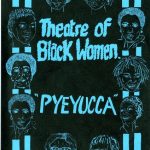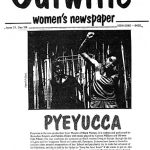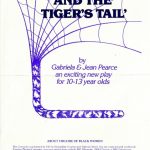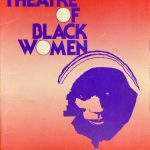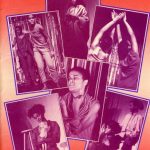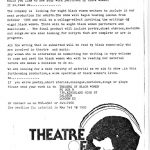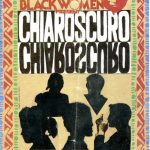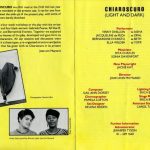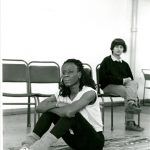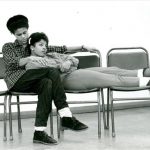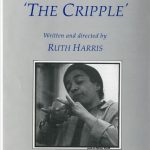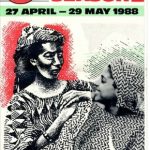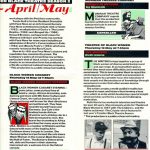Company name: Theatre of Black Women
Founders: Bernardine Evaristo, Patricia Hilaire, Paulette Randall
Established: 1982
Reason: The company founders met at Rose Bruford College, part of an unusually high intake of black students. During their studies they performed shows at Oval House: Prejudice with Patricia Hilaire, Paulette Randall, Robert West, Joan Williams, assisted by Siobhan Lennon and David Sulkin and Coping directed by Yvonne Brewster which involved five black women from Rose Bruford College and ‘explored the relationship between black women and black men in England’. The latter show was devised by and researched with black audiences, both 1980. Through their collaboration on final projects and involvement with the Royal Court’s Writers’ Workshops, where Randall’s Fishing and Hilaire’s Just Another Day were produced as part of the Young Writers’ Festival 1982, they formed a company first to re-stage the one-woman shows they had devised, for a wider audience: Chameleon (Randall ), Hey Brown Girl (Hilaire), Tiger, Teeth Clenched Not To Bite (Evaristo, all 1983). Paulette Randall later withdrew from the company and went on to direct extensively in black theatre including with Temba, Nitro/ Black Theatre Co-op and on a freelance basis, especially the work of August Wilson.
Current status: Disbanded.
Area of work: Black & Asian, Women
Policy: To explore the experience of black women. ‘Theatre is a powerful mode of communication and Theatre of Black Women is the only permanent Black women’s theatre company in Britain. As such we concern ourselves with issues such as Black women in education, health housing, feminism in history and in the Arts. Our theatre is about the lives and struggles of black women and provides an opportunity for Black women’s voices to be heard positively through theatre. We use theatre to promote positive and encouraging images of Black women as individuals, examining and re-defining relationships with men, living independent lives, giving and receiving support from other Black women, discovering their own Black identity, celebrating their Black womanhood’ (1985).
Structure: Collective
Based: London (Kingsland High Street, Dalston, E8 2NS)
Funding: Greater London Council, Arts Council, Greater London Arts Association, Gulbenkian Foundation, NW Arts, Hackney Council, Inner London Education Authority, London Borough Grants
Performance venues: Oval House, Drill Hall, Soho Poly, London and England-wide touring. Also Amsterdam and West Germany.
Audiences:
Company work and process:
The company ran extensive workshops on drama and theatre writing for young women including for girls in Hackney, young and unemployed Black women and through Women in Entertainment. In Evaristo and Hilaire devised the first of two shows: Silhouette and Pyeyucca, exploring self-image and history. Silhouette addresses mixed-race identity and black women’s internalisation of white racist values as self-hatred. One of the first black companies to eschew realism, or the theatre of political persuasion, in favour of a poetic aesthetic which would allow a deeper and more inward exploration of black female identity and its contradictions and complexities, a style strongly influenced by American writers Ntozake Shange (especially her choreopoem for colored girls who have considered suicide/ when the rainbow is enuf
Evaristo and Hilaire went on to establish workshops in directing, design and other theatre skills and, themselves both poets, to commission external writers, especially poets, to develop work for performance with Jackie Kay whose Chiaroscuro was one of the first British plays to focus on black lesbian experience, and Gabriela and Jean Pearse whose children’s play Miss Quashie and the Tiger’s Tale (1986) drew on the African-Caribbean folk-tales of Anansi the spider. Like the earlier devised plays Chiaroscuro uses ritual, story-telling stylised movement, symbolism and poetic language to explore its theme, but intersperses these with naturalistic scenes focusing on four contemporary women. Ruth Harris wrote and directed the company’s final shows: The Children and the harrowing monologue The Cripple, based on the life of Pauline Wiltshire, recounting her experience of disability and social rejection, rape, abandonment and single parenthood. The company were also involved in organising a Black Women in the Arts conference for 1986. Theatre of Black Women’s scripts are largely unpublished.
Reviews:
Triple bill: Chameleon, Hey Brown Girl , Tiger, Teeth Clenched Not To Bite
‘The Theatre of Black Women from South London is Paulette Randall, Pat Hilaire and Bernardine Evaristo who write and perform excellently. Each piece had something very real to say about the experiences of growing up in and coming to terms with this society, as a Black women. The piece that sticks most in my mind is C[h]ameleon… It started with a schoolgirl jogging onto the stage… The play focused on something we’ve all gone through – learning when it’s okay to speak English english or
’Back Home’ English. Set with our schoolgirl talking to an unseen Black, then white, friend, and ending up with her being totally confused… Another piece Hey Brown Girl is about the dilemma many Black feminists must face, that of her race or her sex. A Black man is saying to the woman how her friends have changed her, and where is her loyalty to her race? Eventually the woman just has to say, ‘Fighting you brothers comes first’. (Dorothea Smart, Spare Rib, Dec 1982)
Silhouette
‘On a Spartan stage the two women resurrect from silence and invisibility some of the history and experiences unique to the lives of Black women. A slavewoman takes Pat a young Londoner on a dream-like visit back to various phases in her life. The slavewoman interweaves as she goes for comparison and contrast events from her own life. An evocative language of poetry is used by the characters to explore the many subjects, which in different ways permeate both their lives.’(Maxine in Spare Rib 138, Jan 1984)
Pyeyucca
‘It explores black woman and self-image and examines the ways the black woman has been portrayed through the media and how these stereotypes have their mark on black women today. We ask the question to what extent we have absorbed white society’s and the black male’s definition of ourselves and how do we fight againist the life-long conditioning that has us so narrowly defined.’ (Listings, Spare Rib, 145 Aug-84)
‘Delve into a black woman’s psyche. Challenge the audience black/white/male/female. No comfortable shirk-out allowed. Doesn’t sound like a comfortable night out at the theatre? You’re right. Yet Pyeyucca is an ace piece of touring theatre and not without humour. Laura’s course from girlhood to womanhood is charted through movement and poetic language: her Yoruba mother is into Bach; her Coltrane-playing father from Nevis. A European black Laura is subjected by the dominant white culture: the weapons of her subjection are psychiatry and education. Her sexuality is represented by duality of personality which the physical juxtaposition of Patricia Hilaire (Laura) and Bernardine Evaristo (Pyeyucca) unifies with the power of the music. Repressed Laura ‘born in love’ is ‘living in blood’. Her alter ego Pyeyucca fights back. Will laura acknowledge her true self? If soft talk, hot iron and soul food mean anything to you – Check it.’ (Maud Sulter, City Limits, Nov 1984)
‘Pyeyucca is the rebel black spirit. She haunts Laura without rest: at home, through conformity at school, through the corridors of the ‘special school’ where Laura is sent when her divided psyche can no longer cope. And finally she liberates her. To what? We do not know and cannot imagine. The point of Pyeyucca lies not in pragmatic details but in the wanting – the trapped black desire for liberation.’
‘Bernardine Evaristo and Patricia Hilaire are compelling performers and work easily together. What’s missing is any proper exploration of physical space. Such a short spare piece really needs experimentation with form to really bring the words more fully alive.’ (Barney Bardsley, Tribune, Jan 1985)
Productions:
| PRODUCTION NAME | VENUES | DATES |
|---|---|---|
| Chameleon Writer: Paulette Randall Hey Brown Girl Writer: Patricia Hilaire Tiger, Teeth Clenched Not To Bite Writer: Bernardine Evaristo Director: Jude Alderson Cast: Paulette Randall; Patricia Hilaire; Bernardine Evaristo | Extracts as part of Talking Black
International Women’s Theatre Festival, Melkweg, Amsterdam | 1983 |
| Silhouette Writers: Patricia Hilaire and Bernardine Evaristo | Oval House Also 10 month tour of London including Brent Black Theatre Festival, Loughborough, Bristol, and Festival of Migrant Workers, Frankfurt, West Germany | 1983/4 |
| Pyeyucca Writer: Bernardine Evaristo with additional material by Patricia Hilaire Director: Vanessa Revill Musicians: Carmel Williams, Olivette Cole-Wilson Publicity design: Ingrid Pollard | 1985 | |
| Miss Quashie and the Tiger’s Tale Writers: Gabriela and Jean Pearse | ILEA venues | 1986 |
| Chiaroscuro Writer: Jackie Kay Cast: Vinny Dhillon as Aisha, Jacqueline de Peza as Opal, Bernardine Evaristo as Beth, Ella Wilder as Yomi Musicians: Rita Charles, Sonia Davenport Director: Joan Ann Maynard Composer: Gail-Ann Dorsey Design: Helena Roden Lighting Designer and Stage Manager: Erica Brown ASM: Carol Tavernier Admininstrator: Jennifer Tyson | Extensive tour including: Cockpit, Soho Poly, Oval House | 1986 |
| The Cripple Writer: Ruth Harris Cast: t.m. Murphy Costume assistant: Pauline Wiltshire | Tour including: Sheffield, Ipswich, Oval House, London Lesbian and Gay Centre | 1987 |
| The Children Writer: Ruth Harris Director: Ruth Harris Cast: Gwyneth Whyte: Mitti, Kinti: Hannah Andrews, Jennifer Thorne, Doreen Blackstock Design, Stage Manager etc: Paul St John Shaw Admininstrators: Bernardine Evaristo, Patricia Hilaire, Zhana Poster: Dianne Ceresa | 1987 | |
| The Writers Writer: Ruth Harris | Public rehearsed reading as part of Camden Arts and Entertainment Black Theatre Season 27 April – 29 May 1988, Theatro Technis | 1988 |
Bernardine Evaristo: has gone on to become a well-known poet and novelist, whose work includes: Island Of Abraham (Peepal Tree, 1994), Lara (first version, ARP 1997, revised version Bloodaxe, 2009), The Emperor’s Babe (Penguin 2001), Soul Tourists (Penguin, 2005), Blonde Roots (Penguin, 2008), Hello Mum (Penguin 2010), Mr Loverman (Penguin, 2013) and the Booker prize-winning Girl, Woman, Other (Penguin, 2019).
Bibliography:
Pyeyucca by Bernardine Evaristo and Patricia Hilaire, 1985 – extracts in Island of Abraham (poems) by Bernardine Evaristo (Peepal Tree Press, 1994) and Passion: Discourses on Blackwomen’s Creativity ed. Maud Sulter (Hebden Bridge: Urban Fox, 1990)
Chiaroscuro by Jackie Kay in Lesbian Plays 1 ed. Jill Davis (London: Methuen, 1987)
‘Black Women Playwrights in Britain’ by Susan Croft in British and Irish Women Dramatists Since 1958 ed. Trevor Griffiths and Margaret Llewellyn-Jones (London: Open University Press, 1993)
Interview with Theatre of Black Women by Susan Croft in The Plot Issue 2, Autumn 1985
Staging Black Feminisms: Identity, Politics, Performance by Lynette Goddard (Basingstoke: Palgrave Macmillan, 2007)
Links: Bernardine Evaristo
Acknowledgements: This page has been developed by Susan Croft from her entry on the company in Companion to Black British Culture ed. Alison Donnell (Routledge, 2001). November 2013
The creation of this page was supported by the National Lottery through the Heritage Lottery Fund.

